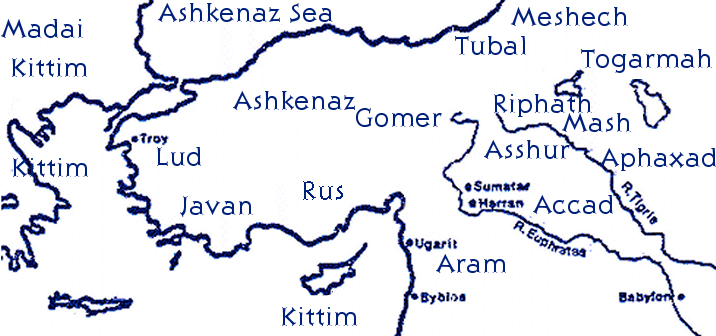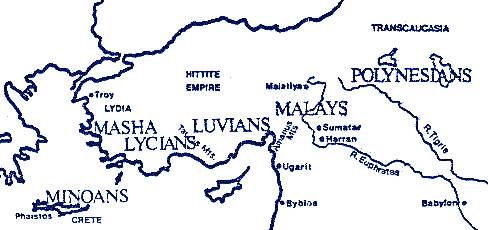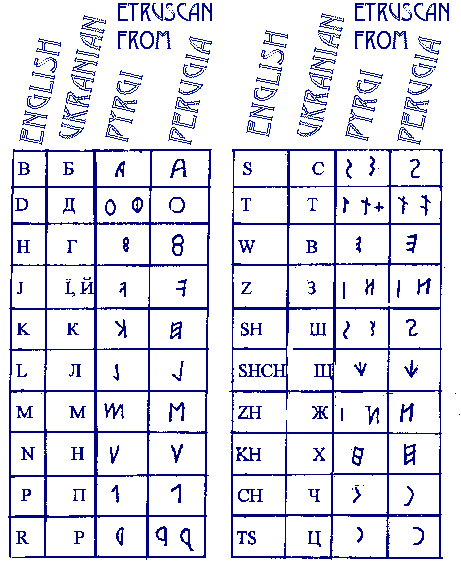 |
 |

The Hebrew word roµ<sh is usually translated "head" and accordingly is rendered here adjectivally, chief (i.e., chief prince). Some expositors have taken this word as a reference to a country known as Rashu (or Reshu), an ancient land along the Tigris River often mentioned in the Assyrian Annals. Others have identified roµ<sh with a people known as the Rus who were connected with the Scythians and lived in the region of the Taurus Mountains in what is present-day Turkey. Some have associated the word with Russia, but this is accomplished only through resemblances in spelling or sound. In accordance with known naming practices in the ancient Near East, the word might also be treated as part of a compound name Rosh Meshech—although no historical confirmation of such a place currently exists.
Meshech and Tubal are generally connected with people who were known to have lived in ancient Anatolia, modern Turkey. Thus, Tabal (Tubal) lay north of Cilicia in eastern Anatolia and Meshech names the ancient Mushki who lived in central Anatolia. Both kingdoms are known to have opposed the Assyrian forces of the eighth century B. C. The king of the Mushki, Mita, has been linked with the famous King Midas, whose touch turned everything to gold.
Gog and Magog (see I Chronicles 1:5) have not been identified with certainty. Magog was the son of Japheth, and the grandson of Noah (Genesis 10:2). Some have connected Gog with a Lydian king in western Anatolia named Gyges, and Magog with the Anatolian Scythians. There has been no end of suggestions as to the identity of Gog and Magog throughout the history of the church (especially Tartars and Turks). The fact that all of the peoples and nations mentioned here lay north of Israel harmonizes well with the uniform predictions of the prophets that in eschatological times enemy forces from the north will descend upon God’s people and land. Many contemporary Bible scholars identify the source of that future attack as Russia.
The precise time of that invasion has been variously understood as:
Regarding the last view, because Gog and Magog are mentioned as combatants in a war at the end of the Millennium (Revelation 20:7–9), many have identified the two battles in Ezekiel and Revelation as one and the same. However, the events following the battles are quite different, as are the events preceding each battle. In Ezekiel’s prophecy, the battle of Gog and Magog is used by God to draw Israel to Himself; in Revelation the battle of Gog and Magog comes after God has drawn His people to Himself for one thousand years of blessing during the Millennium. Therefore, it seems best to place Ezekiel’s battle in the Great Tribulation. See the notes on Daniel 9:26, 27; 11:36, and 11:40–45.
Magog’s allies are listed as Persia (Iran), Ethiopia, Libya, and the tribes of Turkey and Armenia: Meshech, Tubal, Gomer, and Togarmah. The battle itself is described in some detail, including the defeat of Gog (Ezekiel 38:17–39:8), the physical aftereffects of the war (Ezekiel 39:9–20), and the spiritual results of the war (Ezekiel 39:21–29).
The last mentioned effect is twofold: the heathen shall see my [God’s] judgment (Ezekiel 39:21), and the house of Israel shall know that I am the Lord their God from that day and forward (Ezekiel 39:22).1
The question comes to mind as to why God would be against Rus or any of the other peoples named in Ezekiel. The Etruscans, Lydians, Perugians, and Phrygians were experts at divination and used the sheep's liver to do so. A map of a sheep's liver from the Etruscans looks identical to a clay model found in Babylon. The Phaistos Disk that was deciphered by Barry Fell is the instruction to foretell the future by doing certain things. One scholar attributes the Etruscans with having been able to foretell the end of their empire. In fact he says the Etruscans predictions concerning their neighbors to the north, the Russians will be divided into smaller states as they were before the Mongols established what is now Moscow.
An interesting thing in the language of the Etruscans is that John Stoijko maintains that he deciphered the Etruscans alphabet utilizing Ukranian alphabets. More interesting is through his work he relates the word for God in Greek to the word Tiya, the woman also known as Nefertiti. The woman Tiya was worshipped as a goddess and the name is related to the Nubian word for a goddess related to the sun god.
quote
In line 2 the Etruscan were known to Latani (Romans) as "RUSCHI" or "RUSYCHI".
The word Rusychi still used in Ukraine for people of Rus (Rus'ins).
Now let me take few Ukrainian words, which are used in, Etruscan, Greek and Lydian, inscriptions.
Дія and Тія.
Дія = Dija = Diya (' j ' is pronounced as 'y' in yet and ' i ' as double 'ee' in seed).
Please note that in Ukrainian word 'vira' in Latin become 'verus' or ' i ' become 'e'.
Hence 'Diya' become 'Deya' and in Latin become 'Deyus' = God. In English language 'Deyus' is writen as 'Deus'.
And 'Tiya' in Greek becomes 'Teos'
The Diya and Tiya is defined as action, acting, operation, effect and when referred to Supreme Being it will mean "Creator".
unquote
I have included a language correlation chart at bottom of page. Interestingly the alphabets of the Etruscans has similarities to that of the Canaanites, Libyans, and Iberians.
The Hesiod was written by Homer and it is interesting that he records the interaction of the gods with humans in such a way that suggests the gods were something like familiar spirits. Homer was born in the area of Lud (Lydia). The practice of divination and consulting oracles who got their information by consulting a certain spirit was common in that part of the world. It may be that the practice of consorting with demons, familiar spirits and the gods continued until God got fed up with it and/or He knows there will be a revival of these practices in that area of the world.
 |
The map shows the major people groups from a linguistic viewpoint. This is a map of people in Asia from about 1800 B. C. The language deciphered that is on the Phaistos Disk was understood by the groups in large print. Semitic people were driven from the Fertile Crescent about 2000 BC, of which one was Abram along with his family. He cooled his heels in Harran for awhile until the regional drought finally cut food supplies there. The Way of the Sea stretches down along the then coast of Canaan and he made it to Egypt eventually. The mysterious Hittites may have been remnants of the Akkadian empire who re-established themselves in Anatolia for a time. The people of Lydia (Lud) have been related in language studies to people north of the Black Sea, specifically the Ukranians. The Minoans persisted in blocking intermarrying and much unwanted contact from the outside, which may explain why they are not genetically related to the Greeks or Cypriots. Cyprus on the other hand likely was a refuge from those fleeing drought and starvation. Linear A is somewhat related to the language deciphered on the Phaistos Disk. However, Linear B is still not deciphered as far as I know. The Greeks on the other hand, along with Cyprus and islands of the Aegean are surprisingly not closely related to the people on this map except for Cyprus, known as Kittim. Greece is also Kittim and recent genetic studies support them having the same name. The Iberian, Canaanite (Phoenician), Libyan, Galatian, and Celt peoples likely are closely related religiously in that they practiced sun worship. Sun worship was practiced in Anatolia as evidenced by the Hittite winged sun-disk found. Later it is seen that the winged sun-disk shows up at Carchemish in 1300 B. C. and again along with the god Bel. There were several sites in what is now Assyria, Lebanon, and Egypt demonstrating that this worship of the pagans was closely related if not directly in many cultures. The Turks by this time had some people who were not strictly blond and blue-eyed or red headed. The major political entity in the area at this time with a centralized government were the Hittites.
More on the Hittites
Hittites, ancient people of Asia Minor and the Middle East, inhabiting the land of Hatti on the central plateau of what is now Anatolia, Turkey, and some areas of northern Syria. The Hittites, whose origin is unknown, spoke an Indo-European language. They invaded the region about 1900 B. C. and imposed their language, culture, and rule on the inhabitants. In the 17th century B. C., the so-called Old Hittite Kingdom was founded by the Hittite leader Labarna (reigned about 1680-1650 B. C.), or Tabarna, and Hattusa became its capital. Labarna extended his rule to the sea. His successors extended Hittite conquests into northern Syria.
The New Hittite Kingdom
About 1450 B. C. the so-called New Hittite Kingdom was founded. Under the royal prince Suppiluliuma (reigned about 1380-1346 B. C.), this kingdom became a great empire rivaling the power of Egypt, Babylonia, and Assyria. After Suppiluliuma's death, the Hittites maintained their empire, although only by constant warfare. During the late 14th century B. C., the Hittites and Egypt struggled for control of Syria, eventually concluding a treaty of peace. The Hittite Empire fell shortly after 1200 B. C. to invaders called the Sea Peoples in Egyptian records. After the downfall of the empire, a number of Hittite city-states, peopled by a group called Syro-Hittites, emerged in southeastern Anatolia and northern Syria. About 715 B. C. the city states became provinces of the Assyrian Empire.
Early Records and Translations
In 1906 the royal archives of the Hittites were discovered in excavations at Bogazköy, Turkey. The discovery made it possible to decipher the Hittite language. Most of the texts found in the archives were written in this language, but treaties and state letters were written in Akkadian, the international language of the period. The Hittites used the cuneiform system of writing taken from the Babylonians, but they also employed a system of hieroglyphs.
Organization and Achievements
The most outstanding achievements of the Hittite civilization lay in the fields of legislation and the administration of justice. The law codes of the Hittites reveal a strong Babylonian influence, but their justice was far more lenient than that of the Babylonians. The Hittites rarely resorted to the death penalty or to bodily mutilation, both of which were characteristic of other civilizations of the ancient Middle East.
The Hittite economy was basically agricultural. They also had mineral riches and may have been the first people to work iron.
Religion, Art, and Architecture
The Hittites worshipped a variety of gods. Scholars have traced Sumerian, Babylonian, Assyrian, Hurrian, Luwian, and other foreign influences in the Hittite pantheon. Hittite mythology represents a combination of elements that reflect the diversity of cults within the empire. The art and architecture of the Hittites reveal the influence of nearly all the contemporary cultures of the ancient Near East, especially of Babylonia.2
More on other people in what is now modern day Turkey.
The Mycenaeans came to the area of Greece about the same time that Abram migrated from Ur. The same drought and famine in the Fertile Crescent most likely drove the Hamitic people in the Nile Valley to what is now Greece. Civilization in Egypt came to a standstill decimating the population near this time. Likely the weather phenomenon shifted it locus across Africa and the Middle East. The original people in the area of Greece were from Gomer and the migration northward was stopped in what is now modern day Macedonia.
Mycenae
, ancient city in Greece, located near the modern town of Mikínai. The Mycenaeans, celebrated by Greek poet Homer in the Iliad and the Odyssey, may have arrived in Greece around 2000 BC as part of the Indo-European migration. Their language, an early Greek dialect, was written in a script now known as Linear B. About 1400 B. C. Mycenae reached its height as the center of Aegean civilization. In the age of the Trojan War, Mycenae was the leading city in Greece, but about 1200 B. C. its supremacy came to an end. The city never regained its former splendor, and about 468 B. C. it was destroyed by the inhabitants of Argos.3The people of Troy were descended from Lud and comprised part of Lydia. The third layer of the city of Troy is called the burnt layer. This is significant in that the evidence suggests a sudden conflagration. There is the liklihood that a comet piece hit in this area of Anatolia and may be responsible for the unusual sudden drought that ended the Akkadian Empire, forcing migration by the Hamitic people in the Nile Valley, Abram from Ur, and other affected peoples including those inland along the coast of Canaan. Abram and his family stayed in Harran (Hurran) for awhile and then went on to Egypt.
Troy (Asia Minor), also Ilium, city of Greek legend, on the northwestern corner of Asia Minor, in present-day Turkey. During the Trojan War, Troy was captured and destroyed.
Troy was long regarded as a legendary city, but in 1870 German archaeologist Heinrich Schliemann began excavations that unearthed its ruins. This and subsequent excavations have revealed the following successive settlements: Troy I, a settlement dating to about 3000 B. C.; Troy II, a fortress dating from the 3rd millennium BC; Troy III, IV, and V, villages dating from 2300 to 2000 B. C.; Troy VI, a larger fortress dating from 1900 to 1300 B. C. or later; Troy VIIA, a reconstruction of Troy VI, and the city now identified with the Troy of Homeric poems; Troy VIIB and VIII, Greek villages of simple stone houses, dating from about 1100 B. C. to the 1st century B. C.; and Troy IX, the acropolis of the Greco-Roman city of Ilion, or New Ilion, dating from the 1st century B. C. to about A. D. 500.4
Etruscans were descended from Lud and migrated to what is now Italy from Lydia. Some think the Lydians/Etruscans had an empire that included part of the north of the Black Sea (Ashkenaz Sea). The migration from Lydia could have been at the end of their dominance of some 600-800 years of parts of Anatolia.
Etruscans The first Italian towns are established by Etruscans who have emigrated from Lydia after an 18-year famine. Lydia’s King Atys, who rules the Asian country opposite the Greek islands of Chios and Samos, has commanded half his subjects to emigrate. They have journeyed to Smyrna under the leadership of Atys’ son Tyrsanus, they have loaded their belongings onto ships, and they have come to the Italian Peninsula, where their towns are built mostly on hillside terraces and are enclosed with massive timbered walls.5

1Thomas Nelson, Inc., King James Version Study Bible [computer file], electronic ed., Logos Library System, (Nashville: Thomas Nelson) 1997, ©1988 by Liberty University.
2, 3, 4Encarta® 98 Desk Encyclopedia © & ![]() 1996-97 Microsoft Corporation. All rights reserved.
1996-97 Microsoft Corporation. All rights reserved.
5The People's Chronology is licensed from Henry Holt and Company, Inc. Copyright © 1995, 1996 by James Trager. All rights reserved.